Train Crashes and Recency Bias
Two Amtrak crashes in less than a week is newsworthy. It is not, however, a trend.
Two Amtrak crashes in a span of five days had me on the verge of writing a post yesterday wondering why we’re still using 19th Century transportation in the 21st Century, or at least don’t figure out a way to have automobile and locomotive routes not intersect. But I quickly dismissed the idea as recency bias in action, telling myself that there are surely far, far more accidents and fatalities per mile driven by truck, the chief alternative.
Alas, this did not occur to the gang at Axios, who weighed in with a story titled, “The troubling string of Amtrak crashes.” I’m going to quote the story in its entirety here because it’s so short and because it’s sourced entirely from an unlinked AP article.
An Amtrak train en route to Miami from New York collided with a freight train early Sunday morning in South Carolina, killing two individuals and adding another tragic entry to the list of recent Amtrak derailments and crashes, per the AP.
The list, per the AP:
- Jan. 31, 2018: ”A chartered Amtrak train carrying GOP members of Congress to a strategy retreat crashed into a garbage truck at a crossing in rural Virginia, killing 1 person in the truck and injuring 2 others. The cause is under investigation.”
- Dec. 18, 2017: ”3 people were killed and dozens of others were hurt when an Amtrak train derailed as it made its inaugural run along a new 15-mile bypass route in Washington state, en route from Tacoma to Portland, Oregon.”
- April 3, 2016: “2 maintenance workers were struck and killed by an Amtrak train going more than 100 mph in Chester, Pennsylvania. The lead engine of the train derailed.”
- March 14, 2016: ”An Amtrak train traveling from Los Angeles to Chicago derailed in southwest Kansas, sending 5 cars off the tracks and injuring at least 32 people.”
- Oct. 5, 2015: “A passenger train headed from Vermont to Washington, D.C., derailed when it hit rocks that had fallen onto the track from a ledge. 7 people were injured.”
- May 12, 2015: “An Amtrak train traveling at twice the 50 mph speed limit as it entered a sharp curve in Philadelphia and derailed. 8 people were killed and more than 200 injured.”
- March 9, 2015: “At least 55 people were injured when an Amtrak train bound from North Carolina to New Jersey derailed after colliding with an oversized tractor-trailer that was stuck on the tracks in Halifax, North Carolina.”
- June 23, 2014: “An Amtrak train hit a vehicle that was apparently driving on train tracks in Massachusetts, killing 3 people in the vehicle. The train derailed in a remote area.”
- Oct. 21, 2012: “About 12 passengers and crew members on an Amtrak train from Chicago to Pontiac, Michigan, were injured when 2 locomotives and 1 or more coaches derailed after the train lost contact with the track near Niles, Michigan.”
- Oct. 2, 2012: “2 cars and the locomotive of an Amtrak train carrying about 169 passengers derailed after colliding with a semitrailer in California’s Central Valley. At least 20 passengers suffered minor to moderate injuries.”
- June 24, 2011: “A truck slammed into the side of an Amtrak California Zephyr train at a rural crossing 70 miles east of Reno, Nevada, killing 6 people and injuring dozens.”
Twelve crashes over the span of 7-1/2 years may be troubling but it hardly constitutes a “string.”
By comparison, the list of school shootings in the US over the same period is so long that it would take longer than the point is worth to format it, with 126 incidents. That, sadly, is a string.
As noted earlier, the better comparison would be with transport by truck. I can’t readily find statistics on that but the Federal Motor Carrier Safety Commission does track accidents involving large trucks and buses without separating the two. The latest report I can find, Large Truck and Bus Crash Facts 2015, has year-by-year data going back to 1975, with all manner of comparisons available in Excel format near the bottom of the page.
One topline summary from 2015:
- In 2015, 4,311 large trucks and buses were involved in fatal crashes, an 8-percent increase from 2014. Although the number of large trucks and buses in fatal crashes has increased by 26 percent from its low of 3,432 in 2009, the 2015 number is still 18 percent lower than the 21st-century peak of 5,231 in 2005. From 2014 to 2015, large truck and bus fatalities per 100 million vehicle miles traveled by all motor vehicles increased by 1.7 percent, from 0.138 to 0.140.
Additionally:
Over the past year (from 2014 to 2015):
- The number of large trucks involved in fatal crashes increased by 8 percent, from 3,749 to 4,050, and the large truck involvement rate (large trucks involved in fatal crashes per 100 million miles traveled by large trucks) increased by 8 percent, from 1.34 to 1.45.
- The number of large trucks involved in injury crashes decreased by 1 percent, from 88,000 to 87,000, and the large truck involvement rate in injury crashes decreased by 2 percent.
- The number of large trucks involved in property damage only crashes decreased by 1 percent, from 346,000 to 342,000, and the large truck involvement rate in property damage only crashes decreased by 2 percent.
- The number of buses involved in fatal crashes increased from 236 to 261, an increase of 11 percent, and the bus involvement rate in fatal crashes increased by 9 percent.
None of that is to say that we shouldn’t pay attention to train crashes. But they’re hardly our number one transportation-related safety issue, either.
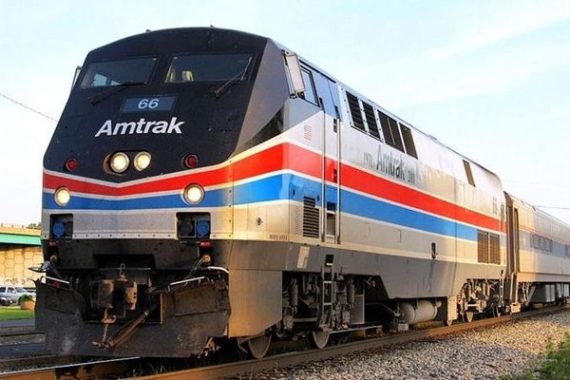

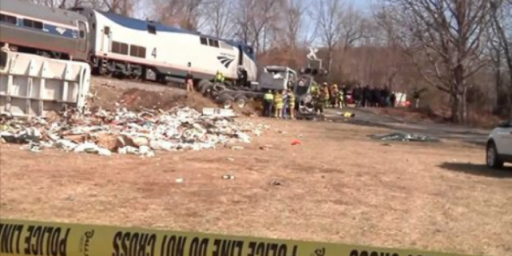
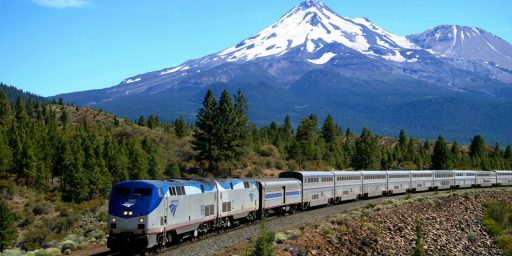
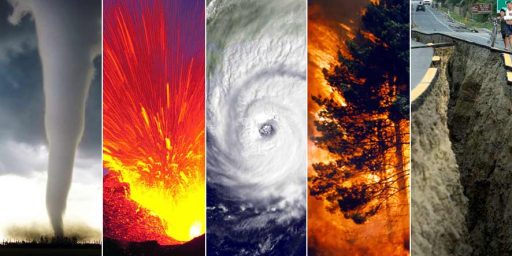
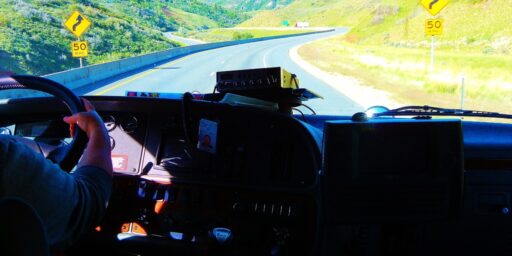
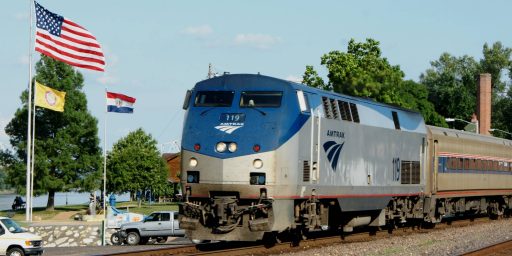
Basically, we don’t know. Four Amtrak crashes in 2018 so far sounds like a lot but since 1980 there have been fewer than 60 Amtrak crashes or derailments and something like 20 billion passenger miles traveled. Determining trends in low frequency events is difficult.
There have been clusters of crashes before (in 2011 IIRC). Those were followed by years of no crashes or only a very few. The data are noisy and not sufficient to make a judgment.
It bears watching but there’s probably no trend here.
Passenger travel by rail is a fraction of total train crashes. I believe that a train somewhere in the US hits a truck everyday. However, this is not the fault of the train. The better headline is “Inattentive Truck Driver Ignores Warnings, Decides A Train Wouldn’t Hurt the Truck”. The only option is to close the crossings, but in rural areas this is not possible.
Ideally, there would be as few rail/road crossings as possible so that accidents like the one that involved the train carrying Members of Congress last week would be minimized. However, that’s not always possible, especially in heavily congested areas such as the Northeast and Mid-Atlantic. What puzzles me, though, is why there are still so many RR/road intersections that are ungated as was apparently the case with the intersection where the collision in Virginia (which, of course, was entirely the fault of the truck driver) took place and often isn’t the case in rural areas. This would seem like an easy enough fix, although I’m admittedly not aware of what it would cost.
The concerning thing about many of the accidents you list, though, is how many of them involved operator error or inattention, often combined with trains traveling far above recommended speeds in given areas. This was the cause of a number of recent high-profile train accidents, including the recent accident in Washington State, another one outside Philadelphia a few years back, and a crash involving a Metro North commuter train traveling from Westchester into NYC several years ago. There is technology that would prevent many of these accidents by remotely slowing trains down in areas where slower speeds are recommended and there were mandates issued that it be installed nationwide issued several years ago, but Amtrak and other agencies have gotten repeated waivers from the Federal Government under Administrations of both parties to “give them more time” to get the job done. What the causes of the delay are is unclear, but dozens of people have died or been seriously injured as a result of the failure to install this technology on the tracks.
Donald Trump took credit for his policies producing a record low in commercial airline fatalities last year. And he’s right. There was a never exceeded low of zero fatalities on scheduled airliners in 2017. As there was in 2016, 2015, 2014, 2013, 2012, 2011, and 2010.
When we got Trump, we got a fascist who can’t even keep the trains running let alone running on time.
He’s pathetic.
@Gustopher:
That’s a decidedly unhelpful observation. First, while he certainly seems not to understand the constraints on his power placed by the Constitution and institutional norms, he’s in no meaningful way a fascist. Second, presidents have essentially nothing to do with whether trains arrive on time, much less crash.
It as needs to be noted it looks like the most recent crash was the fault of CSX, not Amtrak.
Because rail freight is much, much more efficient than truck freight. In the neighborhood of 5x – 10x more efficient. That is not factoring in indirect subsidies trucking companies receive: their trucks travel on public roads primarily funded by gas taxes paid by the gallon. There is no surchage for trucks.
The federal government has estimated that one 40-ton, 18-wheel truck causes the same damage as 9,600 mid-size cars per mile traveled. Yes, trucks are less fuel efficient than cars, big rigs get ~6 MPG, so they do pay proportionally more than passenger cars in gas taxes, but compared to the road damage they cause and the amount it requires to maintain and repair roads, commercial trucking receives a massive taxpayer subsidy.
Rail freight moves on privately owned rails maintained and repaired by the companies that own them.
Trucks are very often required for the last-mile delivery for freight moved by trains, obviously.
Now as to passenger trains, that’s a whole other issue.
@James Joyner: I agree Trump has no more to do with trains than, as I noted above, he has to do with airline safety. That said, there is some degree of validity to Gustopher’s Mussolini reference.
As to Trump being a fascist, I’ll agree it’s more aspirational than effective, mostly because he’s too lazy and ignorant to make it work. Are you confident that the Mercers, Kochs, or their staffs are too lazy and ignorant? I don’t think I disagree with you so much on the substance of his desire for autarchy as on the threshold for worrying about it. I would set that threshold way below it actually being in place.
–BBC, Why the Natzis achieved power .
@James Joyner: “Unhelpful” is a strange word to apply to the question of ?Trump = Fascist. It makes naming something sort of ‘instrumental’ — doesn’t matter what you call it but don’t provoke anyone!
In ‘The Atlantic’ website there is a fairly lengthy piece by James Fallows (a treasure!) stating pretty definitely that one problem with the political response to our present administration is that no one knows what to call it. Trumpocracy? Authoritarianism?
It is absolutely true as far as I can tell there is nothing like the complete ideology and structure that the fascists of the 20’s and 30’s brought to power with them here in this assembly of idiots and wacko’s.
But when the U.S. President tells a crowd in Cincinnati as he did today that Democrats who failed to applaud his State of the Union were being “treasonous” — well, sir, something serious is creeping out of the woods.
What would YOU call it?
Some talk on the radio is that someone or some secretive group has got into the computer systems of airports, trains, and cell phone systems. They also bring up the increase in strange weather, volcano eruptions, earthquakes, and unexplained flying objects.
@Tyrell:
Was it Art Bell or Alex Jones that you heard this from?
@James Joyner: Fine, fine, creeping authoritarian who claims credit for everything good on his watch has something bad happen on his watch. But that doesn’t have the same ring does it?
I’m not sure we can actually absolve him of all responsibility though — he ran on a platform of deregulation, and has appointed incompetent people to head the many various agencies, and one year later, rail safety seems to be slipping. Do we really not see a potential connection? It could be a fluke, or it could be the leading indicator of any number of regulatory failures.
Coal mining deaths are up too.
@Tyrell:..unexplained flying objects.
Sure hope they are not bees in your bonnet!
@JohnMcC:
I’m in agreement with @Gustopher‘s frustration over Trump’s breaking of our norms. I find hyperbole in making the case unhelpful because it actually raises the bar. “He’s no Mussolini” is not the standard to which we ought hold our leaders.
Unseemly. Embarrassing. Unbecoming. But, unless he starts having government agents arrest people, it’s just an old man spouting off from an unfortunate perch.